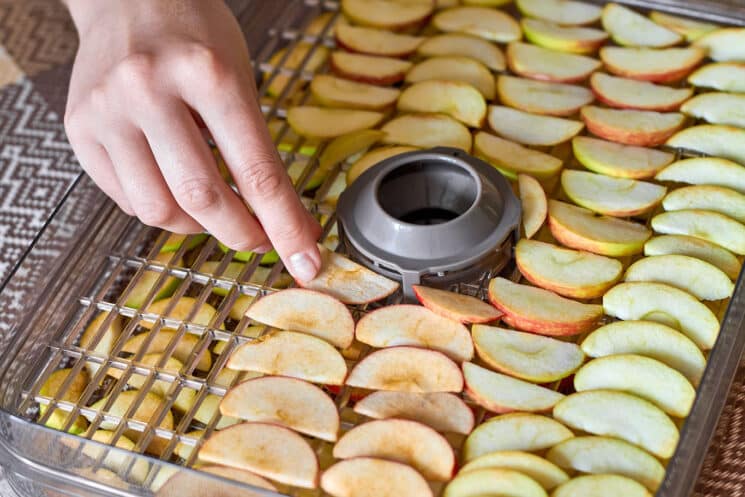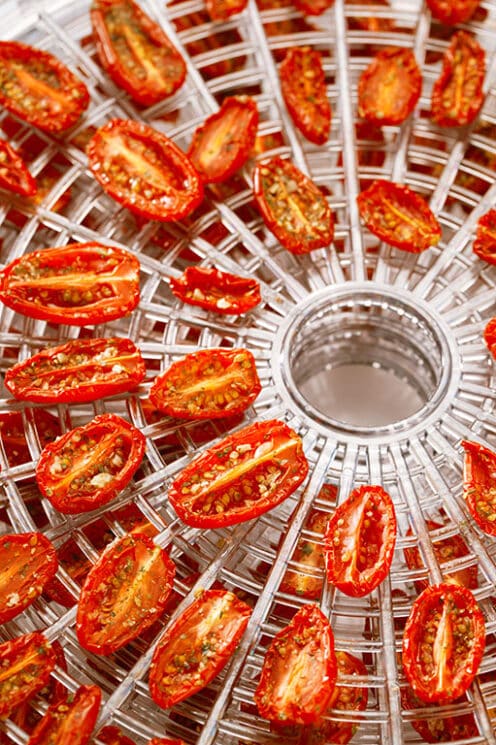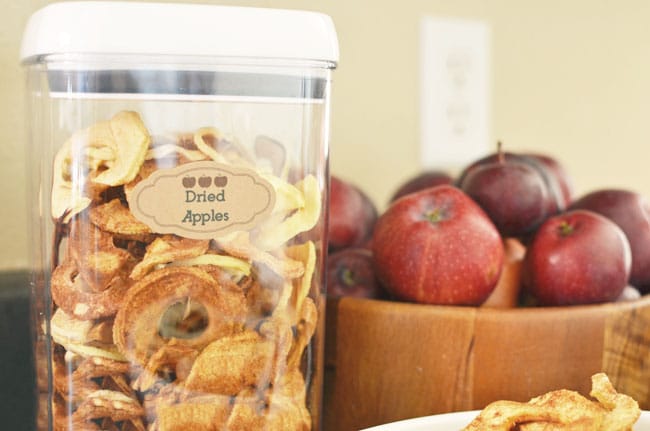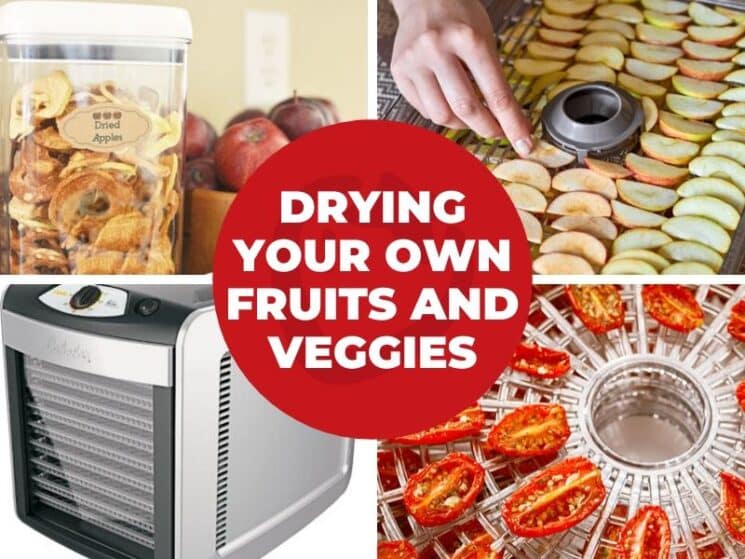How to Dry Your Own Fruits and Veggies
Dried fruit is nature’s candy…and making your own is easier than you think! Here are some easy ways to dry your own fruits and veggies at home.

Benefits of Drying Your Own Fruits and Veggies
- You know exactly what you are eating. Many commercial brands have added sugar and preservatives.
- Less expensive. Drying your own fruit and veggies at home is almost always cheaper, especially compared to organic.
- You get to decide exactly how you want your fruits and vegetables to be prepared. Cooking time, doneness, method, etc.
How to Dry Fruits and Vegetables
Select your Produce
Be sure and select fruits, and vegetables that are ripe (not over ripe,) and in good condition. Make sure your herbs have not flowered. These fruits and veggies are great for drying.
Fruit
- Apples
- Pears
- Apricots
- Bananas
- Peaches
- Berries
- Cherries
- Plums
- Grapes
- Cranberries
Veggies
- Carrots
- Corn
- Peas
- Tomatoes
- Beets
- Zucchini and Yellow Squash
- Onions
- Peas
- Celery
- Corn
- Winter Squash
- Broccoli
Herbs
- Basil
- Oregano
- Cilantro
- Rosemary
- Parsley
- Dill
- Marjoram
- Thyme

Get Your Produce Ready
- Thoroughly wash and dry your fruits/veggies/herbs.
- Peel, pit/core fruit and veggies if it requires. Some fruits and veggies may be dried as they are (berries, broccoli, peas, etc)
- Slice fruit and veggies if needed. The thicker you slice it, the longer it will take to dry. Also, the higher the water content, the thicker it should be sliced because it will shrink more with drying. Keep slices uniform to ensure even drying.
Should I Pretreat my Produce?
Pretreating helps your produce maintain a brighter coloring, prevent browning, and also decreases bacteria growth.
- Fruits. Dip or soak your fruit in a solution of citric acid. Orange, lemon or pineapple juice works great. 1/4 cup juice to 2 cups water is a good solution.
- Vegetables. Blanching is the recommended method. It helps slow or stop the enzyme activity that can cause changes in flavor and texture during storage. Blanching also relaxes tissues so pieces dry faster, and helps protect the vitamin content. To blanch, heat a pot of water to boiling. When your water is boiling put your veggies in for 2-3 minutes. Remove and immediately place in ice water. Dry on a cloth or paper towel.
- Herbs aren’t necessary to pretreat.

Drying
There are 2 methods that are most commonly used.
- Dehydrator. This type of drying produces the highest quality product. They are relatively inexpensive, convenient for drying large or small batches of food, and easy to use. The best dehydrators are controlled by a thermostat and have a fan that blows warm air over the food. When using a dehydrator, place fruit/veggies/herbs on drying racks. The owner’s manual should give specific drying times and temperatures for different types of produce. A general rule of thumb: Fruits/Veggies/Herbs: 4 -12 hours depending on thickness and moisture content. Fruits will usually be somewhat pliable and leathery when done. Vegetables and herbs will be dry and brittle when done.
- Oven. If you don’t own a dehydrator this method can work good also. It does require some watching to prevent scorching. Proper temperature and ventilation are most important in oven drying. Preheat oven at lowest setting (140 to 150 degrees F), then adjust the thermostat and prop the oven door open to achieve a consistent oven temperature of 140 degrees F, and to allow moist air to escape. You can use an oven thermometer to determine temperature. Place it directly on a rack or the drying tray and check it every 2 hours.
I prefer the dehydrator drying method. I have more of a commercial type dehydrator (from Cabelas) that I love. It has lots of racks, and also mats for drying fruit leather, or smaller things like cranberries or peas.
Storing
- Pack cooled, dried foods in small amounts in glass jars or in airtight containers.
- Store in a cool, dry place. Properly stored, dried fruit/vegetables/herbs keep well for six to 12 months.

Using Dried Fruit and Veggies
Dried fruits and veggies are so great to have – beyond just eating them! Here are some ways we like to use them:
Fruit:
- In trail mix
- In baked goods
- In salads
- On cereal, oatmeal and yogurt
Veggies:
- Soups and stews
- Omelets
- On Pizza
- In breads
One of our readers dries celery, spinach, kale, collards and then puts them into a blender and makes them into powder. When she is cooking things like scrambled eggs, meatloaf, etc., she adds her dried veggie powder. Such a great idea!


Natalie Monson
I'm a registered dietitian, mom of 4, avid lover of food and strong promoter of healthy habits. Here you will find lots of delicious recipes full of fruits and veggies, tips for getting your kids to eat better and become intuitive eaters and lots of resources for feeding your family.
Learn More about Natalie
Thanks for all the tips! My husband bought me a dehydrator for Christmas and I love it. Our favorite so far is apples. I guess I must have over-dried them because they got brittle, but it was the best mistake because we LOVE them that way! It’s the best when you’re craving something crunchy! We’re addicted to them!
I love this idea for preserving extra produce from my vegetable garden. I’ve been thinking about canning it, but now I’m wondering if drying the extras would be better! Do you happen to know if drying or canning preserves more of the nutrients of vegetables?
Typically there are some nutrient losses with any type of food preservation. During both drying and canning, there are some water soluble vitamin losses – Vitamin C, Thiamin, Riboflavin, and B6 because they are sensitive to both light and heat. Mineral and fiber content has been shown to be about the same in fresh, frozen, canned and dried fruits and vegetables. Fat soluble vitamins including carotenoids (such as lycopene) vary depending on the specific fruit or vegetable. For example, cooked frozen green peas contained higher levels of beta-carotene than cooked fresh and cooked canned. Compared to fresh tomatoes, canned tomato products have been reported to have high levels of beta-carotene, a precursor of vitamin A. Processed tomatoes are also reported to have higher lycopene content than fresh, possibly due to a heat related release of the nutrient.
I do a lot of canning myself and my suggestion to you would be to preserve your produce using both methods. I think that each method has benefits and can provide variety to your diet.
I think a dehydrator is going on my wish list! This will be perfect to do with all our extra’s from the garden this summer!! Butternut Squash chips sound yummy!!
[…] Drying Your Own Fruits and Veggies: How To When using a dehydrator, place fruit/veggies/herbs on drying racks. The owners manual should give specific drying times and temperatures for different types of produce. A general rule of thumb: Fruits/Veggies/Herbs: […]
Hi, I live in India where we hv good sunlight. Can we dry things in sunlight rather than dehydrator/oven? Thanks.
Nitu –
Yes you can dry things in the sun – it just takes a LOT longer. And you will want to find a way to keep things from landing in your food (bugs, dirt, leaves, etc) For example, to dry fruit leather in the oven or a dehydrator takes several hours, whereas in the sun in might take 1-2 days. We used to dry things in the sun all of the time when I was little. Give it a try!
Hey, I see you use the Cabela’s dehydrator. I wondered if you have every used any other style & why you chose this one. I want to make sure I purchase the best one.
Thanks so much for your great website.
:0)
What would you suggest doing with dried veggies – other than simply snacking on them?
I do this every time we camp. Short straw hikes 10 miles of dried greens and meat for everyone. 🙂